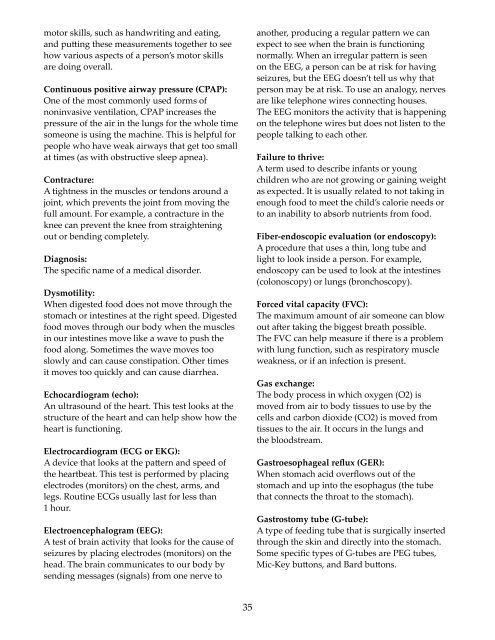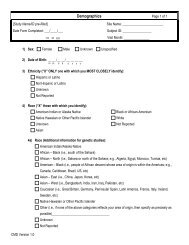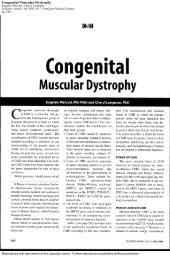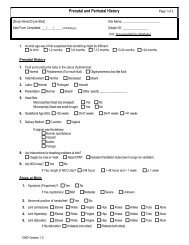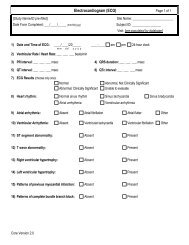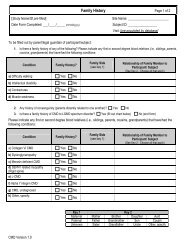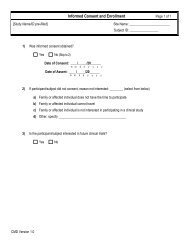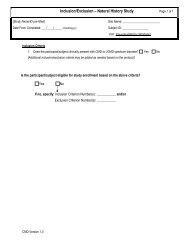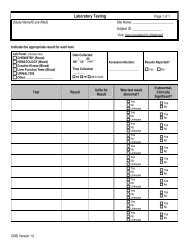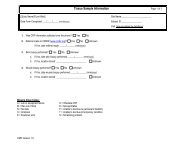The Management of Congenital Muscular Dystrophy ... - Cure CMD
The Management of Congenital Muscular Dystrophy ... - Cure CMD
The Management of Congenital Muscular Dystrophy ... - Cure CMD
You also want an ePaper? Increase the reach of your titles
YUMPU automatically turns print PDFs into web optimized ePapers that Google loves.
motor skills, such as handwriting and eating,and putting these measurements together to seehow various aspects <strong>of</strong> a person’s motor skillsare doing overall.Continuous positive airway pressure (CPAP):One <strong>of</strong> the most commonly used forms <strong>of</strong>noninvasive ventilation, CPAP increases thepressure <strong>of</strong> the air in the lungs for the whole timesomeone is using the machine. This is helpful forpeople who have weak airways that get too smallat times (as with obstructive sleep apnea).Contracture:A tightness in the muscles or tendons around ajoint, which prevents the joint from moving thefull amount. For example, a contracture in theknee can prevent the knee from straighteningout or bending completely.Diagnosis:<strong>The</strong> specific name <strong>of</strong> a medical disorder.Dysmotility:When digested food does not move through thestomach or intestines at the right speed. Digestedfood moves through our body when the musclesin our intestines move like a wave to push thefood along. Sometimes the wave moves tooslowly and can cause constipation. Other timesit moves too quickly and can cause diarrhea.Echocardiogram (echo):An ultrasound <strong>of</strong> the heart. This test looks at thestructure <strong>of</strong> the heart and can help show how theheart is functioning.Electrocardiogram (ECG or EKG):A device that looks at the pattern and speed <strong>of</strong>the heartbeat. This test is performed by placingelectrodes (monitors) on the chest, arms, andlegs. Routine ECGs usually last for less than1 hour.Electroencephalogram (EEG):A test <strong>of</strong> brain activity that looks for the cause <strong>of</strong>seizures by placing electrodes (monitors) on thehead. <strong>The</strong> brain communicates to our body bysending messages (signals) from one nerve toanother, producing a regular pattern we canexpect to see when the brain is functioningnormally. When an irregular pattern is seenon the EEG, a person can be at risk for havingseizures, but the EEG doesn’t tell us why thatperson may be at risk. To use an analogy, nervesare like telephone wires connecting houses.<strong>The</strong> EEG monitors the activity that is happeningon the telephone wires but does not listen to thepeople talking to each other.Failure to thrive:A term used to describe infants or youngchildren who are not growing or gaining weightas expected. It is usually related to not taking inenough food to meet the child’s calorie needs orto an inability to absorb nutrients from food.Fiber-endoscopic evaluation (or endoscopy):A procedure that uses a thin, long tube andlight to look inside a person. For example,endoscopy can be used to look at the intestines(colonoscopy) or lungs (bronchoscopy).Forced vital capacity (FVC):<strong>The</strong> maximum amount <strong>of</strong> air someone can blowout after taking the biggest breath possible.<strong>The</strong> FVC can help measure if there is a problemwith lung function, such as respiratory muscleweakness, or if an infection is present.Gas exchange:<strong>The</strong> body process in which oxygen (O2) ismoved from air to body tissues to use by thecells and carbon dioxide (CO2) is moved fromtissues to the air. It occurs in the lungs andthe bloodstream.Gastroesophageal reflux (GER):When stomach acid overflows out <strong>of</strong> thestomach and up into the esophagus (the tubethat connects the throat to the stomach).Gastrostomy tube (G-tube):A type <strong>of</strong> feeding tube that is surgically insertedthrough the skin and directly into the stomach.Some specific types <strong>of</strong> G-tubes are PEG tubes,Mic-Key buttons, and Bard buttons.35


